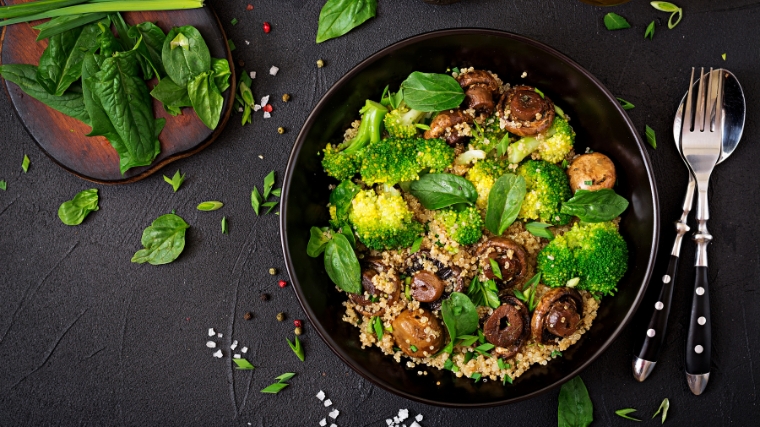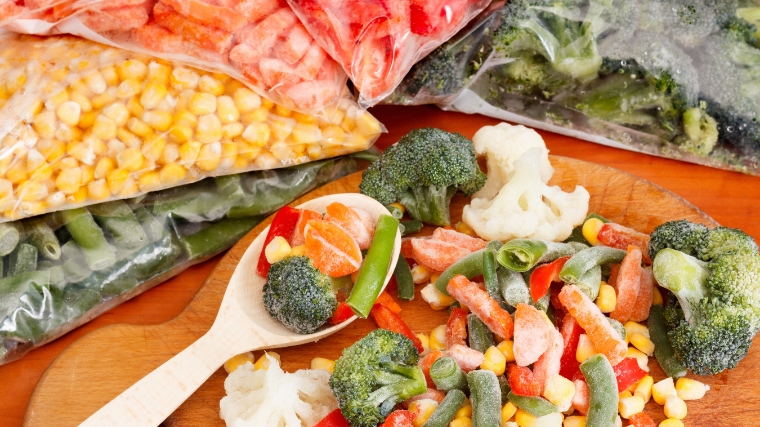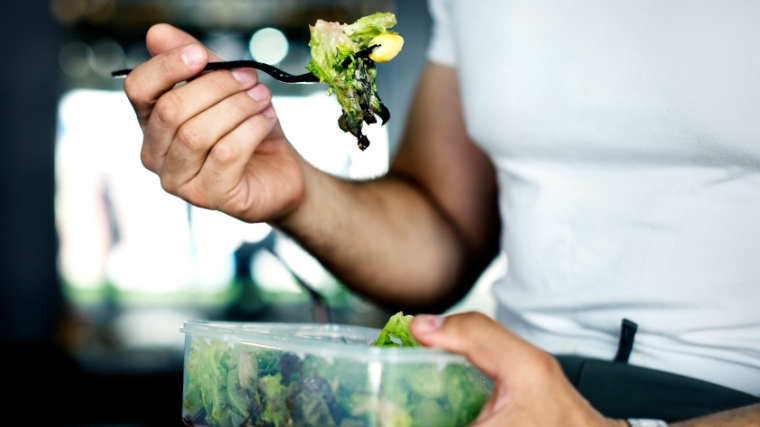In all likelihood, you spent your childhood being told — in no uncertain terms — to eat your broccoli and spinach. Whether you grew up hating them or just don’t feel like you have enough time to work them into your diet as an adult, you may not be in the habit of getting greens on your plate.
Especially if you’re a strength athlete and like to focus on your protein intake, it’s all too easy to skip the veggies and go right to the heart of the meal. But a lot happens to your body when you don’t eat enough vegetables. Here, you’ll learn about the risks of not eating vegetables and how to get enough veggies in your diet.

Editor’s Note: The content on BarBend is meant to be informative in nature, but it should not be taken as medical advice. When starting a new training regimen and/or diet, it is always a good idea to consult with a trusted medical professional. We are not a medical resource. The opinions and articles on this site are not intended for use as diagnosis, prevention, and/or treatment of health problems. They are not substitutes for consulting a qualified medical professional.
Risks of Not Eating Enough Vegetables
There are many complex factors related to access to affordable vegetables. Individuals and communities who live in food deserts — areas without affordable, readily-available access to fresh food — are also likely to be exposed to economic and environmental stressors that can contribute to poor health outcomes. (1)(2)(3)(4)(5)
In addition to regional inequity in fresh vegetable availability in the United States, nationwide vegetable supply across the globe is often lower than what is required to meet the recommended intake for adults. (6)
Because of these complexities, it can be hard to tell which factors are responsible for which health outcomes. (3)(7) Still, research does suggest that there are direct, negative health impacts of not getting enough veggies in your diet. (7)
Higher Risk of Diseases
It’s not just about clearing your plate because your parents are telling you to. Eating enough vegetables daily can help reduce your risk of getting non-communicable diseases — that is, diseases that aren’t contagious, like heart disease and cancer. (7) Inadequate vegetable intake has been linked to a greater risk of asthma, hypertension, strokes, pancreatic diseases, cardiovascular diseases, anemia, and colon, liver, lung, and rectal cancer. (7)(8)(9)(10)(11)(12)(13)
Increased Mortality Rate
Given the extensive list of diseases that one is at risk for when they don’t eat enough vegetables, it perhaps isn’t surprising that all-cause mortality rates go up as vegetable intake goes down. (14)(15)(16)(17)
Eating more fruits and vegetables is associated with lower all-cause mortality rates, especially cardiovascular-related mortality. (14)(15)(16)(17)
Reduced Mental Health
Depression has been associated with inadequate vegetable intake. (7)(18) Research suggests that an increase of 100 grams of vegetable intake per day may reduce the risk of depression by three percent. (19) There has also been some research linking less than four daily servings of vegetables to the experiences of people with psychosis. (20)
Benefits of Eating Vegetables
They might not always be the part of the meal you’re most looking forward to, but getting your vegetables can be quite a delicious experience. It’s also one of the best things you can do for your health. Here’s why.
Lower Risk of Disease
Diets that include five servings per day of cruciferous vegetables (think: broccoli, cauliflower, cabbage, and Brussels sprouts) and dark-green leafy vegetables (like collards and kale) have been linked to significantly lower rates of cardiovascular disease. (21)
Eating enough vegetables seems to have a protective effect against chronic diseases like diabetes, different cancers, cardiovascular diseases, and even Alzheimer’s disease. (22) Similarly, it stands to reason that since low vegetable intake is associated with higher disease rates across the board, eating more vegetables can have a positive impact on your overall health and lower the risk of disease. (7)(8)(9)(10)(11)(12)(13)
Improved Mental Health
Eating your greens may not just be good for your body. It can also be good for your mind. Research suggests that eating enough vegetables — especially green leafy vegetables — is associated with lower rates of depression and psychological distress. (18)(20)(19)(7)
There isn’t a cut-and-dry case of cause and effect between mental health and vegetable consumption. However, there does seem to be a clear correlation between eating five servings of vegetables each day and improved mental health. (18)(20)
How Many Servings of Vegetables Do You Need Per Day?
The World Health Organization (WHO) and the Food and Agricultural Organization (FAO) recommend eating a minimum of 400 grams of fruits and vegetables per day — that totals about five servings (two and a half to three cups) each day. (23)
However, once you hit your recommendation, you don’t have to eat even more. Research suggests that the benefits taper off around five servings per day. (14) So while you should aim for five servings of vegetables each day, eating more than that won’t necessarily give you added benefits. (14)(21)
But if steamed broccoli or raw carrot sticks aren’t your things, don’t despair. Even 100-percent vegetable juice and processed veggies “count” toward your recommended daily intake. (23) And in case you were wondering — you definitely were — potatoes also contribute to the mission of getting enough veggies.
How to Eat More Vegetables
You might be busy bustling between kids, personal time, and your job — or you just haven’t liked veggies in the past and don’t see a way forward. Either way, it can feel like a chore to get to that benchmark of five servings per day. Here’s how to make it easier to eat more vegetables.
Buy Frozen or Canned Veggies
Accessing and affording fresh veggies can be tough. Opt for bags of frozen vegetables or canned veggies (preferably without additives) to keep in the freezer or pantry. Frozen veggies are relatively easy to cook in a pan — just slap on the pan’s lid and cook them at medium heat, stirring occasionally. You can also roast them, put them in a slow cooker, or even pop them in an air fryer.

Frozen and canned veggies go in pretty much anything, from stir fries and casseroles to quiches and pasta. Nutritionally, frozen and canned vegetables tend to have just as many nutrients as their fresh counterparts. (24) They’re also typically much more cost-effective than buying fresh produce, too. (24)
Prioritize Your Plate
Check out your plate every time you make a meal for yourself. Is it 50 percent vegetables? If not, you may be missing out on your vegetable needs.
When you’re putting your meal together, put vegetables on the plate first. Then, try to fill it with 50 percent veggies. If it’s a meal like breakfast where veggies don’t always feel like the intuitive star of the show, try integrating some into your eggs or morning soup.
Stacking your plate with veggies first will help make portioning easier and ensure that you’re getting enough greens. If you find yourself still hungry, feel free to go back for seconds.
Eat Vegetables First
Eating your vegetables first with each meal may help you get a higher veggie intake total each day. (25) The study in question was conducted with pre-schoolers, suggesting that kids who ate the vegetables on their plate before eating anything else were the ones who overall got more veggies each day. (25)

It might be tempting to dismiss this kids-oriented study as not applying to grown-ups with jobs and 500-pound deadlifts. But research suggests that people’s attitude about vegetables is influenced by what they learned and felt about veggies growing up. (26)(27) So take a lesson from the kiddos in the study and eat your vegetables first.
Find the Veggies You Like
Contrary to what you might have thought as a child, vegetables don’t have to be bland or taste bad. That said, not everyone has to like every food. So it’s important to find out what vegetables you like and how to prepare them in a way that tastes good to you.
Research shows that people who find vegetables boring or don’t like the taste are less likely to eat them. (28) To conquer this barrier, take some time to figure out which vegetables you don’t like and which ones you do.
Experiment with different ways of preparing veggies to make them taste good to you. You might hate spinach in salads, but love it when it’s cooked with a little sriracha.
You can also get veggies through 100-percent vegetable juices and other processed sources like dried veggies and vegetables in powdered form. (23)(29) So if you need to supplement your intake with 100 percent carrot juice and some greens powder, have at it.
Get Social Support
Accessing fresh vegetables can be tough enough. Learning to prepare them in a way you like can also be a journey. Make it easier on yourself by recruiting social support to help you stay on track with your vegetable goals. Research suggests that a lack of social support can contribute to inadequate vegetable intake. (30)
Set yourself up for success by treating your nutrition like your strength training sessions. Get yourself the equivalent of a gym buddy to help keep both of you accountable to your veggie-intake goals.
Have That Broccoli
If vegetables are the bane of your nutritional existence, it’s not just you. Adults all around the world have trouble getting their recommended daily intake of five servings, even when veggies are readily available. But that doesn’t mean all is lost.
Ward off the negative health impacts of inadequate vegetable intake by finding which veggies you like, making them tasty, and having at least two and a half to three cups each day.
References
- Abildso CG, Bias TK, Coffman J. Adoption and Reach of a statewide policy, systems, and environment intervention to increase access to fresh fruits and vegetables in West Virginia. Transl Behav Med. 2019 Oct 1;9(5):847-856.
- Gans KM, Gorham G, Risica PM, Dulin-Keita A, Dionne L, Gao T, Peters S, Principato L. A multi-level intervention in subsidized housing sites to increase fruit and vegetable access and intake: Rationale, design and methods of the ‘Live Well, Viva Bien’ cluster randomized trial. BMC Public Health. 2016 Jun 28;16:521.
- Hilmers A, Hilmers DC, Dave J. Neighborhood disparities in access to healthy foods and their effects on environmental justice. Am J Public Health. 2012 Sep;102(9):1644-54.
- Wang M, Zhou T, Song Q, Ma H, Hu Y, Heianza Y, Qi L. Ambient air pollution, healthy diet and vegetable intakes, and mortality: a prospective UK Biobank study. Int J Epidemiol. 2022 Aug 10;51(4):1243-1253.
- Chen Z, Herting MM, Chatzi L, Belcher BR, Alderete TL, McConnell R, Gilliland FD. Regional and traffic-related air pollutants are associated with higher consumption of fast food and trans fat among adolescents. Am J Clin Nutr. 2019 Jan 1;109(1):99-108.
- Kalmpourtzidou A, Eilander A, Talsma EF. Global Vegetable Intake and Supply Compared to Recommendations: A Systematic Review. Nutrients. 2020 May 27;12(6):1558.
- Angelino D, Godos J, Ghelfi F, Tieri M, Titta L, Lafranconi A, Marventano S, Alonzo E, Gambera A, Sciacca S, Buscemi S, Ray S, Galvano F, Del Rio D, Grosso G. Fruit and vegetable consumption and health outcomes: an umbrella review of observational studies. Int J Food Sci Nutr. 2019 Sep;70(6):652-667.
- Boeing H, Bechthold A, Bub A, Ellinger S, Haller D, Kroke A, Leschik-Bonnet E, Müller MJ, Oberritter H, Schulze M, Stehle P, Watzl B. Critical review: vegetables and fruit in the prevention of chronic diseases. Eur J Nutr. 2012 Sep;51(6):637-63.
- Bamia C, Lagiou P, Jenab M, Aleksandrova K, Fedirko V, Trichopoulos D, Overvad K, Tjønneland A, Olsen A, Clavel-Chapelon F, Boutron-Ruault MC, Kvaskoff M, Katzke VA, Kühn T, Boeing H, Nöthlings U, Palli D, Sieri S, Panico S, Tumino R, Naccarati A, Bueno-de-Mesquita HB, Peeters PH, Weiderpass E, Skeie G, Quirós JR, Agudo A, Chirlaque MD, Sanchez MJ, Ardanaz E, Dorronsoro M, Ericson U, Nilsson LM, Wennberg M, Khaw KT, Wareham N, Key TJ, Travis RC, Ferrari P, Stepien M, Duarte-Salles T, Norat T, Murphy N, Riboli E, Trichopoulou A. Fruit and vegetable consumption in relation to hepatocellular carcinoma in a multi-centre, European cohort study. Br J Cancer. 2015 Mar 31;112(7):1273-82.
- Wang Y, Li F, Wang Z, Qiu T, Shen Y, Wang M. Fruit and vegetable consumption and risk of lung cancer: a dose-response meta-analysis of prospective cohort studies. Lung Cancer. 2015 May;88(2):124-30.
- Pomerleau J, Lock K, McKee M. The burden of cardiovascular disease and cancer attributable to low fruit and vegetable intake in the European Union: differences between old and new Member States. Public Health Nutr. 2006 Aug;9(5):575-83.
- van’t Veer P, Jansen MC, Klerk M, Kok FJ. Fruits and vegetables in the prevention of cancer and cardiovascular disease. Public Health Nutr. 2000 Mar;3(1):103-7.
- Ghose B, Yaya S. Fruit and vegetable consumption and anemia among adult non-pregnant women: Ghana Demographic and Health Survey. PeerJ. 2018 Feb 21;6:e4414.
- Wang DD, Li Y, Bhupathiraju SN, Rosner BA, Sun Q, Giovannucci EL, Rimm EB, Manson JE, Willett WC, Stampfer MJ, Hu FB. Fruit and Vegetable Intake and Mortality: Results From 2 Prospective Cohort Studies of US Men and Women and a Meta-Analysis of 26 Cohort Studies. Circulation. 2021 Apr 27;143(17):1642-1654.
- Genkinger JM, Platz EA, Hoffman SC, Comstock GW, Helzlsouer KJ. Fruit, vegetable, and antioxidant intake and all-cause, cancer, and cardiovascular disease mortality in a community-dwelling population in Washington County, Maryland. Am J Epidemiol. 2004 Dec 15;160(12):1223-33.
- Wang X, Ouyang Y, Liu J, Zhu M, Zhao G, Bao W, Hu FB. Fruit and vegetable consumption and mortality from all causes, cardiovascular disease, and cancer: systematic review and dose-response meta-analysis of prospective cohort studies. BMJ. 2014 Jul 29;349:g4490.
- Bellavia A, Larsson SC, Bottai M, Wolk A, Orsini N. Fruit and vegetable consumption and all-cause mortality: a dose-response analysis. Am J Clin Nutr. 2013 Aug;98(2):454-9.
- Głąbska D, Guzek D, Groele B, Gutkowska K. Fruit and Vegetable Intake and Mental Health in Adults: A Systematic Review. Nutrients. 2020 Jan 1;12(1):115.
- Saghafian F, Malmir H, Saneei P, Milajerdi A, Larijani B, Esmaillzadeh A. Fruit and vegetable consumption and risk of depression: accumulative evidence from an updated systematic review and meta-analysis of epidemiological studies. Br J Nutr. 2018 May;119(10):1087-1101.
- Hahn LA, Galletly CA, Foley DL, Mackinnon A, Watts GF, Castle DJ, Waterreus A, Morgan VA. Inadequate fruit and vegetable intake in people with psychosis. Aust N Z J Psychiatry. 2014 Nov;48(11):1025-35.
- Wallace TC, Bailey RL, Blumberg JB, Burton-Freeman B, Chen CO, Crowe-White KM, Drewnowski A, Hooshmand S, Johnson E, Lewis R, Murray R, Shapses SA, Wang DD. Fruits, vegetables, and health: A comprehensive narrative, umbrella review of the science and recommendations for enhanced public policy to improve intake. Crit Rev Food Sci Nutr. 2020;60(13):2174-2211.
- Del Río-Celestino M, Font R. The Health Benefits of Fruits and Vegetables. Foods. 2020 Mar 23;9(3):369.
- Liu RH. Health-promoting components of fruits and vegetables in the diet. Adv Nutr. 2013 May 1;4(3):384S-92S.
- Miller, S. R., & Knudson, W. A. (2014). Nutrition and cost comparisons of select canned, frozen, and fresh fruits and vegetables. American Journal of Lifestyle Medicine, 8(6), 430-437.
- Yang J, Tani Y, Tobias DK, Ochi M, Fujiwara T. Eating Vegetables First at Start of Meal and Food Intake among Preschool Children in Japan. Nutrients. 2020 Jun 12;12(6):1762.
- Pem D, Jeewon R. Fruit and Vegetable Intake: Benefits and Progress of Nutrition Education Interventions- Narrative Review Article. Iran J Public Health. 2015 Oct;44(10):1309-21.
- Ramsay SA, Rudley M, Tonnemaker LE, Price WJ. A Comparison of College Students’ Reported Fruit and Vegetable Liking and Intake from Childhood to Adulthood. J Am Coll Nutr. 2017 Jan;36(1):28-37.
- Mc Morrow L, Ludbrook A, Macdiarmid JI, Olajide D. Perceived barriers towards healthy eating and their association with fruit and vegetable consumption. J Public Health (Oxf). 2017 Jun 1;39(2):330-338.
- Sarfo J, Pawelzik E, Keding GB. Are processed fruits and vegetables able to reduce diet costs and address micronutrient deficiencies? Evidence from rural Tanzania. Public Health Nutr. 2022 Sep;25(9):2637-2650.
- Griffith DM, Cornish EK, McKissic SA, Dean DA. Differences in Perceptions of the Food Environment Between African American Men Who Did and Did Not Consume Recommended Levels of Fruits and Vegetables. Health Educ Behav. 2016 Dec;43(6):648-655.
Featured Image: Timolina / Shutterstock